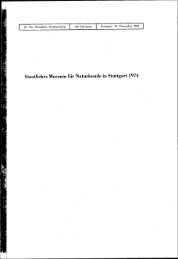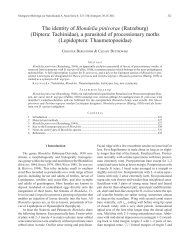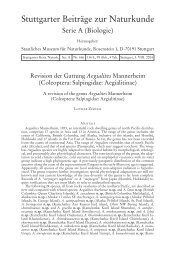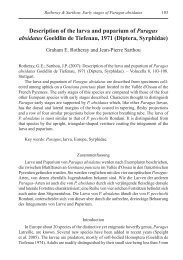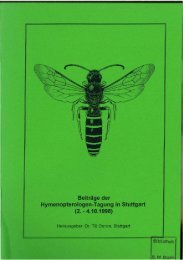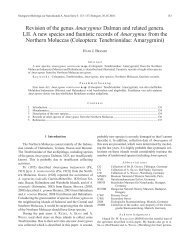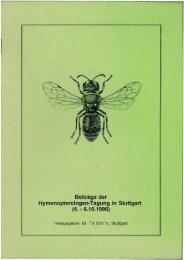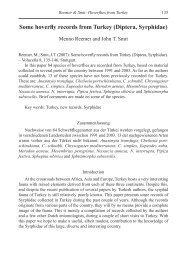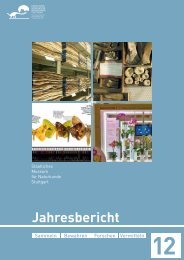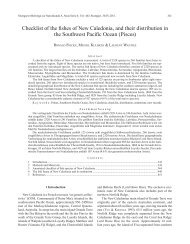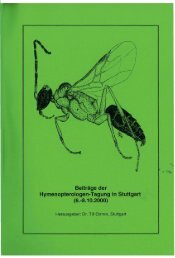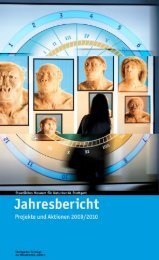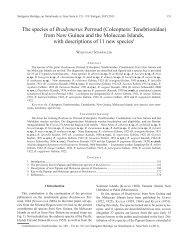Serie A (Biologie) - Staatliches Museum für Naturkunde Stuttgart
Serie A (Biologie) - Staatliches Museum für Naturkunde Stuttgart
Serie A (Biologie) - Staatliches Museum für Naturkunde Stuttgart
You also want an ePaper? Increase the reach of your titles
YUMPU automatically turns print PDFs into web optimized ePapers that Google loves.
schawaller, oriental species of bradymerus 5AcknowledgementsFor the trustful and often extended loan of material I want to express first my gratitude toall friends and colleagues listed in the compilation of collections. The hospitality of Dr. OTTÓMERKL (Budapest), RUTH MÜLLER (Pretoria) and Dr. EVA SPRECHER (Basel) during my visitsfor comparative studies is greatly appreciated. Own field work in Asia was supported duringdifferent trips by Dr. ROLAND GRIMM (Tübingen), Dr. CHRISTOPH HÄUSER (<strong>Stuttgart</strong>), Dr.MARTIN HAUSER (Urbana/Illinois), Prof. Dr. JOCHEN MARTENS (Mainz) and JÜRGEN TRAUT-NER (Filderstadt). Last but not least I thank JOHANNES REIBNITZ (<strong>Stuttgart</strong>) again for professionallyproducing the photographs with the automontage system and for arranging theplates.2 Species charactersThe combination of the following characters are considered as species-specific:Body length with a certain variability. Dorsal side ferrugineous, brownish or blackish,without or with metallic shine. Genae distinctly broader or not broader thaneyes. Frons with or without distinct supraorbital keels and/or supraorbital furrows.Last 3, 4, 5 or 6 antennomeres forming a club. Pronotum of different shape. Anteriorcorners of pronotum protruding or not protruding. Lateral margin of pronotumwithout or with distinct crenulation. Pronotal disc with rough and confluent or withfine and separate punctation, between punctures with or without granules. Pronotaldisc with or without medial furrow/impression. Elytral intervals without or withtubercles/keels, equal on all intervals or only partly, often similar only on alternateintervals. Tibiae in both sexes externally with or without distinct keels. Sometimessexually dimorphic femora and tibiae present in males (sometimes unvisible fromdorsal and to be overlooked, so also by GEBIEN 1925). Aedeagus of different shape.Apart from the sexually dimorphic femora and tibiae in some species, the externalcharacters of males and females are identical. Thus, a few single females are also describedas new species if the external characters are adequate for taxonomic separation– some further females must remain undescribed.3 The known Oriental species of BradymerusBradymerus acutangulus Gebien, 1925 (Figs. 3, 74)Studied type material: Java, Preanger, leg. P. F. SIJTHOFF, 1 syntype NHMB-F (labelledby GEBIEN as type), designated herewith as lectotype.New material: None.Diagnostic characters: Dorsal view see Fig. 3, dorsal side dark ferrugineouswithout metallic shine, body length 6.5 mm. Genae not broader than eyes, fronswithout distinct supraorbital keels but with deep supraorbital furrows. Last 5 antennomeresforming a club. Anterior corners of pronotum extremely protrudingand acute, lateral margin without distinct crenulation, pronotal disc with roughpunctation and without medial impression, between punctures without granules.Elytral intervals with high and partly confluent granules. Tibiae in both sexes externallywithout distinct keels. Aedeagus see Fig. 74.Distribution: Java.



